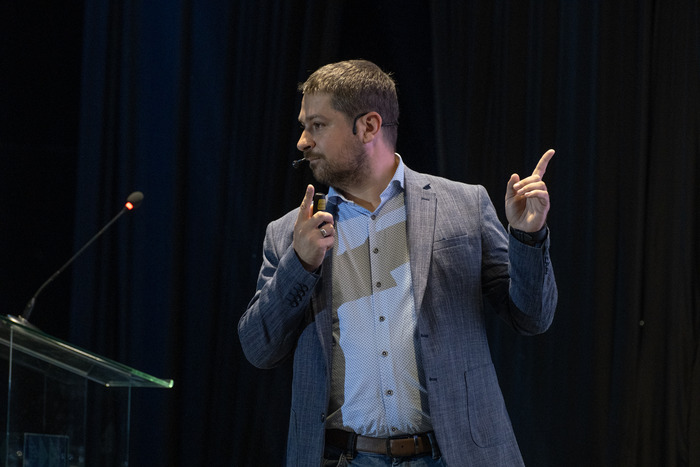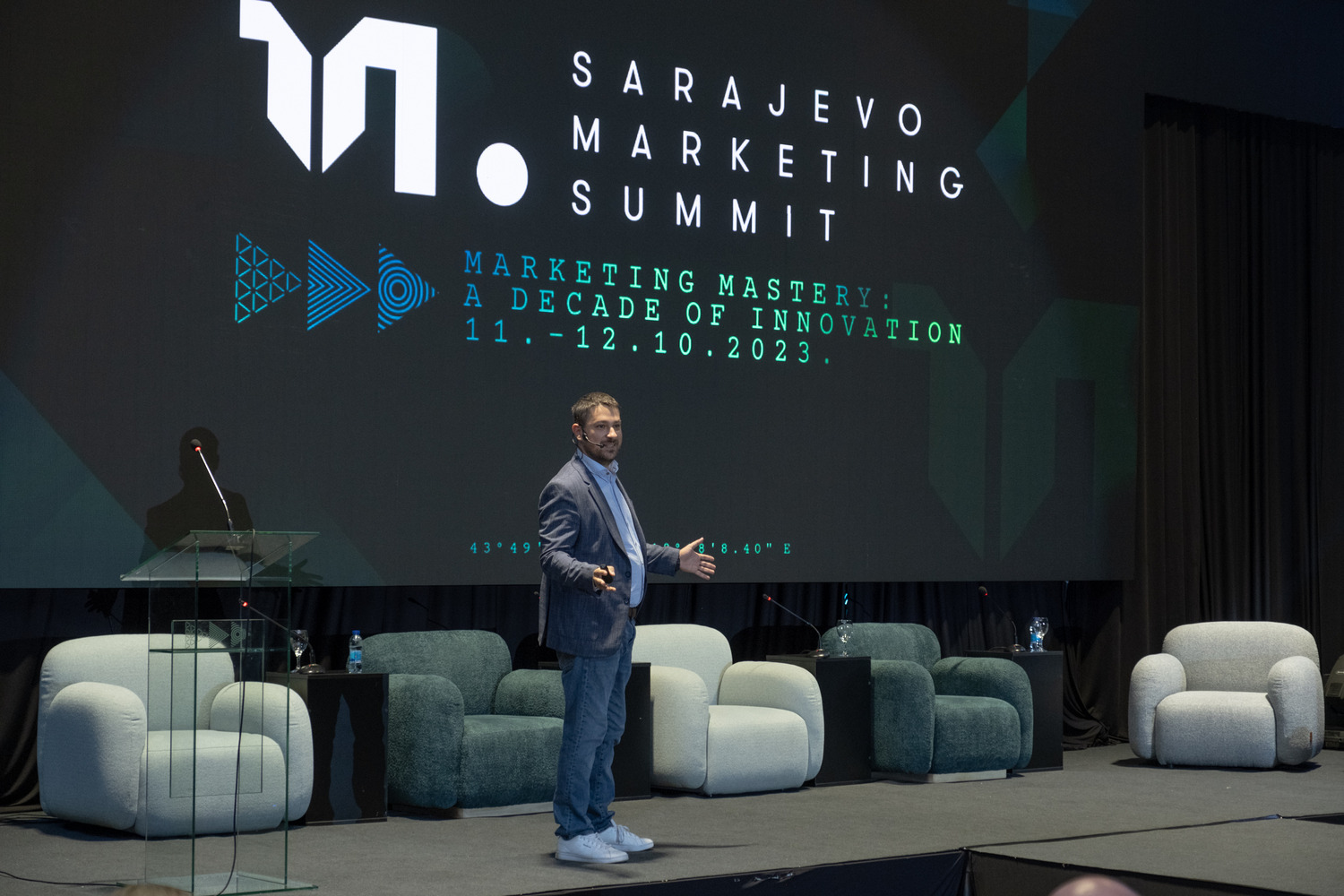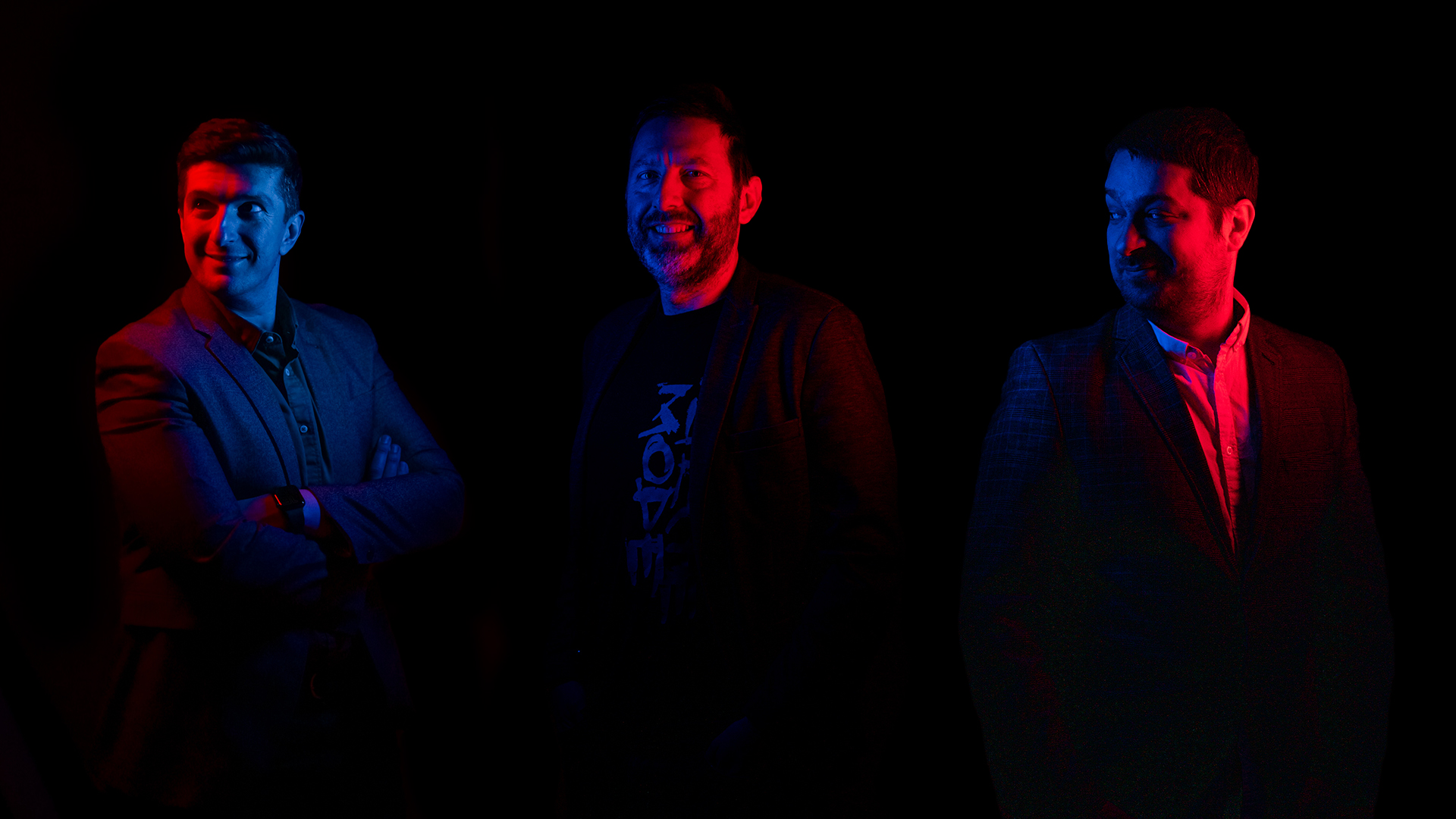On October 12th our Partner and Creative Director at Piksel LTD, Vladimir Ristevski, gave an awesome presentation at Sarajevo Marketing Summit 2023, a conference that gathers directors, managers, and researchers in marketing, PR, branding, and many other industries. He discussed the importance of innovation and synergy in marketing agencies by exploring the past, present, and future of marketing mastery.
“Marketing Mastery” was, in fact, the theme that celebrated the 10th Sarajevo Marketing Summit and emphasized the continuous growth and evolution in marketing. So, having such a compelling topic in hand, told through the insights of our Creative Director, we thought you might find it valuable. 😊
Enjoy the excerpt of his presentation below:
Innovation is the lifeblood of marketing in the 21st century. It is the driving force behind creating value, solving problems, and satisfying customers. Innovation is not only about inventing new products or services but also about finding new ways to communicate, connect, and collaborate with your target audiences.

The Decade of Remarkable Transformations
The past decade has witnessed a remarkable transformation in the marketing landscape, thanks to the emergence and evolution of various technologies, platforms, and tools that have enabled marketers to reach and engage their customers in unprecedented ways. Some of the most notable innovations in marketing include:
1. Social Media: Social media has changed the way people consume, create, and share information. It has also given marketers access to a wealth of data and insights about their customers’ preferences, behaviors, and sentiments. Social media has also empowered customers to become co-creators and advocates of brands, as well as influencers and critics of their peers.
2. Artificial Intelligence: Artificial intelligence has enabled marketers to automate and optimize various aspects of their marketing campaigns, such as content creation, personalization, segmentation, targeting, analytics, etc. Artificial intelligence has also enhanced the customer experience by providing relevant and timely recommendations, assistance, and feedback.
3. Personalization: Personalization has become a key differentiator and competitive advantage for marketers in the era of information overload and customer empowerment. Personalization allows marketers to tailor their messages, offers, and experiences to each customer based on their needs, interests, and preferences. Personalization also increases customer loyalty, satisfaction, and retention.
4. Content Marketing: Content marketing has emerged as one of the most effective and engaging ways to attract, educate, and persuade customers. Content marketing involves creating and distributing valuable, relevant, consistent content that informs, entertains, or inspires customers. Content marketing also helps marketers establish credibility, authority, and trust with their customers.
A Dynamic Mindset for Continuous Innovation
These are just some examples of how innovation has shaped the marketing world in the past decade. Innovation is not a one-time event or a static state, but a continuous process and a dynamic mindset.
As marketers, we need to embrace innovation as a core value and a strategic priority. We need to constantly explore new opportunities, experiment with new ideas, and evaluate new results. We need to be curious, creative, and courageous in our pursuit of innovation. Only then can we achieve marketing mastery in the 21st century.

Synergy Across Departments: Fostering Collaboration
Synergy across departments is the ability and willingness of different teams within an organization to work together effectively and efficiently toward a common goal.
Synergy across departments is essential for innovation, allowing the organization to leverage its employees’ diverse skills, knowledge, and perspectives. Synergy across departments also fosters a culture of collaboration, learning, and improvement within the organization.
Challenges and Opportunities
However, achieving synergy across departments is not easy. It requires overcoming various challenges, such as:
1. Silos: Silos are the barriers that prevent communication, coordination, and cooperation among different departments. Silos can be caused by factors such as organizational structure, hierarchy, culture, processes, systems, etc. Silos can result in duplication, confusion, conflict, and inefficiency within the organization.
2. Resistance: Resistance is the reluctance or refusal of some employees or teams to collaborate with others. Resistance can be caused by factors such as fear of change, lack of trust, lack of motivation, lack of skills, lack of resources, etc. Resistance can result in isolation, stagnation, frustration, and dissatisfaction within the organization.
3. Complexity: Complexity is the difficulty or uncertainty of managing multiple projects, tasks, and stakeholders across different departments. Complexity can be caused by factors such as scope creep, changing requirements, conflicting priorities, interdependencies, etc. Complexity can result in delays, errors, risks, and waste within the organization.

Overcoming Challenges
To overcome these challenges and create synergy across departments, organizations need to seize various opportunities, such as:
1. Alignment: Alignment is the alignment of vision, mission, values, goals, and strategies across different departments. Alignment ensures that everyone in the organization is on the same page and working in the same direction. Alignment also creates a sense of purpose and meaning for the employees and teams.
2. Engagement: Engagement is the engagement of employees and teams in collaborative activities and initiatives across different departments. Engagement involves creating opportunities for communication, feedback, recognition, and reward among different departments. Engagement also builds trust and rapport among employees and teams.
3. Empowerment: Empowerment is the empowerment of employees and teams to make decisions and take actions that support collaboration across different departments. Empowerment involves providing autonomy, authority, accountability, and resources to employees and teams. Empowerment also fosters creativity and innovation among employees and teams.
Synergy Across Agencies: Partnering for Success
Synergy across agencies is the ability and willingness of different marketing agencies to work together effectively and efficiently toward a common goal. Synergy across agencies is essential for innovation, as it allows the agencies to leverage the diverse skills, expertise, and resources of their partners. Synergy across agencies also fosters a culture of cooperation, learning, and improvement among the agencies.

The Benefits of Synergy Across Agencies
The benefits of synergy across agencies include:
1. Quality: Synergy across agencies improves the quality of the marketing campaigns, as the agencies can deliver more value, creativity, and impact to their clients. Synergy across agencies also enhances the quality of the customer experience, as the agencies can provide more consistent, relevant, and personalized messages and offers to the customers.
2. Efficiency: Synergy across agencies increases the efficiency of marketing campaigns, as the agencies can reduce costs, risks, and waste by sharing expenses, responsibilities, and best practices. Synergy across agencies also increases the efficiency of the customer journey, as the agencies can streamline processes, systems, and channels to make it easier and faster for customers to find, buy, and use their products or services.
3. Growth: Synergy across agencies boosts the growth of the marketing campaigns, as the agencies can reach and engage more customers by expanding their markets, segments, and networks. Synergy across agencies also boosts the growth of customer loyalty, as the agencies can retain and delight more customers by offering more value, benefits, and rewards.
Best Practices of Synergy Across Agencies
The best practices of synergy across agencies include:
1. Communication: Communication is the foundation of synergy across agencies. Communication involves establishing clear and frequent communication channels among the agencies to share information, feedback, and insights. Communication also involves creating a common language and terminology among the agencies to avoid confusion and misunderstanding.
2. Coordination: Coordination is the execution of synergy across agencies. Coordination involves aligning goals, strategies, plans, and actions among the agencies to ensure that they are working toward the same direction and outcome. Coordination also involves managing interdependencies, conflicts, and changes among the agencies to ensure they work in harmony and flexibility.
3. Collaboration: Collaboration is the enhancement of synergy across agencies. Collaboration involves creating opportunities for innovation, learning, and improvement among the agencies to generate new ideas, solutions, and results. Collaboration also involves building trust, respect, and appreciation among the agencies to foster a positive and productive relationship.

Synergy Across Fees and Value Proposition: Value-Based Pricing
The future of marketing agency fees and value proposition is based on the principle of value-based pricing, which means that the fees are determined by the value that the agency delivers to the client, rather than by the cost or time that the agency incurs.
Value-based pricing aligns the interests and incentives of both parties, as it rewards the agency for creating value and impact, and it ensures that the client pays for the results and outcomes that they desire.

The McKinsey Model
One of the models that can help agencies implement value-based pricing is the McKinsey model, which consists of four steps:
1. Define the value proposition: The value proposition is the statement that summarizes how the agency will help the client achieve their goals and solve their problems. The value proposition should be specific, measurable, achievable, relevant, and time-bound (SMART). The value proposition should also include the key benefits and differentiators that the agency offers to the client.
2. Estimate the value potential: The value potential is the amount of value the agency can create for the client based on the value proposition. The value potential can be estimated using various methods, such as benchmarking, forecasting, modeling, etc. The value potential should be expressed in monetary terms, such as revenue, profit, cost savings, etc.
3. Negotiate the value share: The value share is the percentage of the value potential that the agency will receive as its fee. The value share can be negotiated with the client based on various factors, such as risk, competition, relationship, etc. The value share should be fair and reasonable for both parties, and it should reflect the agency’s contribution and performance.
4. Monitor and adjust: The monitor and adjust step involves tracking and measuring the actual value that the agency delivers to the client over time. The monitor and adjust step also involves adjusting the fee accordingly based on the actual results and outcomes. This step should be transparent and collaborative, and it should involve regular feedback and communication between the agency and the client.
In Conclusion
We have seen how synergy is the key to transforming marketing agencies for a decade of innovation. Synergy is not only beneficial for innovation but also for customer satisfaction. By creating synergy, marketing agencies can deliver more value, creativity, and impact to their clients and their customers.
Synergy also fosters a culture of cooperation, learning, and improvement among marketing agencies. Synergy unleashes the potential of marketing agencies to achieve marketing mastery in the 21st century. Embrace innovation, foster synergy, and chart the path to marketing excellence.

Let’s change the way agencies and clients collaborate!



